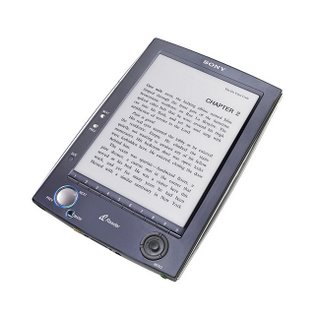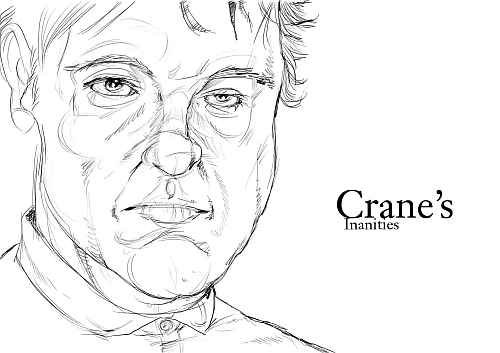 This is the Sony Portable Reader System, also known as the PRS-500. This is supposed to be Sony's answer to those who complained that reading books on their Personal Digital Assistant was too uncomfortable to do for any length of time. No one likes eyestrain. From some British newspaper:
This is the Sony Portable Reader System, also known as the PRS-500. This is supposed to be Sony's answer to those who complained that reading books on their Personal Digital Assistant was too uncomfortable to do for any length of time. No one likes eyestrain. From some British newspaper:"Unlike other e-books, the screen has no flicker or back light, allowing the reader to spend as much time reading as they want without the fear of eyestrain."The 6-inch screen can be taken for a monochrome liquid-crystal display at first glance, but on closer inspection looks like no other electronic display. It's behind a thin pane of glass, but unlike an LCD it shows no "depth" - it pretty much looks like a light grey piece of paper with dark gray text."
For me, the matter of eyestrain was always the key reason not to bother with these so-called "e-books". Reading a name and number or even a short news article off of a PDA was fine. Attempting to read a chapter of a novel on a PDA, however, had me squinting in no time, and wishing for the ole reliable Luddite version. But the other night, while reading a mass-market paperback edition of the 1,000-plus page Jonathan Strange & Mr Norrell, my hand was beginning to feel the strain of keeping that stack of paper cracked open for more than half an hour. A machine that's "the size of a paperback book, but only a third of an inch thick," which is how the article describes the PRS-500, sounds like a device I could try and read a book on.
Now comes the part where I ask a silly question whose answer is undoubtedly a quick and annoyed 'no'. Here goes: Is this the beginning of the end for the printed word? For proof that we shouldn't sell our stock in Barnes & Noble quite yet, this too from the article: "Like paper, the display is readable from any angle, but it doesn't look as good as the real thing, chiefly because the contrast doesn't compare well. The background isn't white and the letters aren't black. The letters show some jaggedness, even though the resolution is a very respectable 800 by 600 pixels." See? As cool as it is, it's still not as good as looking at a regular piece of paper with words printed in ink on it. The machines are winning, sure, but they haven't won yet.
Anywho! Like I said, next week will feature many a blog posting, but today I push away from the computer to write middling to bad fiction with naught but pen and paper. See ya next week.

4 comments:
Digital paper was supposed to come out years ago. Not sure what this Sony device uses, but some tech groups were in the early development of something known as digital paper that didn't work like an LCD at all. In fact, it used millions of tiny squares lined side by side in a grid that would form a sort of screen. Each one of these squares has a white side and a black side. Given a tiny charge a square would flip from white to black.
If the grid was given a series of well placed charges, the image of a written page would appear. I guess that technology was filed somewhere under 'obscure tech that failed'. Still, I'd much rather hold in my hands some sort of real paper item - something about all these PDA and digi-paper ideas seem so awkward to me. But, maybe with the next generation of kids, paper will be bye-bye, especially if we keep filling their heads with this recycling crap. Anyhow, lates.
I'd actually much rather see this Sony product designed with businesses in mind. If you've ever worked in an office then you know exactly how colossal the amount of paper waste is. Whether you're anti-recycling like Heath O'Malley here, you have to know investing in a Sony Reader over 27 bazillion reams of paper a year would be sound economics. Instead of handing out orientation notebooks, companies could provide each empoyee with one of these Sony readers pre-loaded with all the documents they'll need. If they make these things Wi-Fi compatible, then you could walk into a presentation and immediately download any materials (spreadsheets, pie charts, bar graphs, etc.) onto your reader and wouldn't have to squint to see the crappy overhead projection across the room. You could zap files from Reader to Reader and could minimize the number of emails sent in a given day (saving time) along with reducing paper waste (and money). But then why would they want to do that?
As for replacing books, I don't see it unless they take it the other way and add bells and whistles that make it comparable to a dvd book instead of just a vhs book. Let's say you could have the DaVinci Code complete with illustrations, glossaries, clips from the movie, etc., etc., then you might have something. But right now I agree that it just seems like something for people who don't want to hurt their hands. I suppose there is some appeal if you can store multiple books on one machine and select, like on your iPod, which ever book strikes your fancy...but then, you could just get an iPod, buy a bunch of audio books, and have those, music, podcasts, movies, games, text, and photos in a device both smaller and lighter than a Sony Reader.
Hmm. Screw this thing.
It's akin to how I feel about CDs vs. downloads. I liked CDs (hell, I liked tapes, to), mainly because I felt like the whole package was part of what the artist was putting out there - the jacket design, the image on the disc, etc. Each one had it's own world. I find that when I download music, I tend to not have any idea what the song names are, though they're all there on the iPod. I also tend to forget what album a song is on, because I have no image in my mind of what album it is, etc. Sure, the new iPods are chipping away at that excuse, but still.
Each book is its own little world. Devices like this tend to make all the little worlds look exactly the same. At some point, they'll all come in the same holder. They'll seem homogenous.
People like me will die out, though, as the younger generation is much more used to not having album art and, on the whole, not being so much into books. Hell, even I read more online in a day than I do from a page.
Hoard your books now.
Crane's writing for a dinosaur world... haha.
Post a Comment